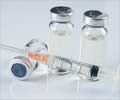3D-printed microneedle patches can help bring vaccines to the masses.
- A mobile vaccine printer can create hundreds of vaccine doses daily, to be used wherever vaccines are needed
- The printer generates microneedle-containing patches that, when applied to the skin, dissolve the vaccine without the need for traditional injection
- The ink used to print the patches contains RNA vaccine molecules encased in lipid nanoparticles, making it stable for extended periods
A microneedle vaccine printer for thermostable COVID-19 mRNA vaccines
Go to source).
Mobile Vaccine Printer-A Solution to Vaccine Shortage
MIT researchers have proposed a solution to this problem: a mobile vaccine printer that can be scaled up to generate hundreds of vaccine doses daily. According to the researchers, this type of printer, which can fit on a tabletop, might be used anywhere vaccines are needed. The printer creates patches with hundreds of vaccine-containing microneedles. When the patch is applied to the skin, the vaccine dissolves without the need for a traditional injection. Once printed, the vaccine patches can be kept at room temperature for months.In a report published today in Nature Biotechnology, the researchers demonstrated that they could utilize the printer to create thermostable COVID-19 RNA vaccines that may provoke an immunological response equal to that generated by injectable RNA vaccines in mice.
Printing Vaccines
Most vaccines, including mRNA vaccines, must be refrigerated while in storage, making them difficult to stockpile or ship to regions where those temperatures cannot be maintained.Furthermore, they necessitate the use of syringes, needles, and qualified healthcare workers to administer them.
To overcome this barrier, the MIT team set out to develop a method for producing vaccines on demand. Prior to the arrival of COVID-19, their main objective was to create a device capable of rapidly producing and deploying vaccines during disease outbreaks such as Ebola. A gadget like this may be transported to a remote village, refugee camp, or military base to allow for mass vaccinations.
Instead of developing typical injectable vaccinations, the researchers chose a novel method of vaccine delivery based on patches the size of a thumbnail that contains hundreds of microneedles. Vaccines of this type are now being developed for a variety of diseases, including polio, measles, and rubella. When the patch is put on the skin, the needle tips disintegrate, and the vaccine is released.
"When COVID-19 started, concerns about vaccine stability and vaccine access motivated us to try to incorporate RNA vaccines into microneedle patches," Daristotle says.
Vaccine Printing Ink
The "ink" used by the researchers to print the vaccine-containing microneedles contains RNA vaccine molecules encased in lipid nanoparticles, which allows them to remain stable for lengthy periods of time.The ink also contains polymers that may be easily molded into the desired shape and remain stable for weeks or months, even when stored at room temperature or higher. The researchers discovered that a 50/50 mixture of polyvinylpyrrolidone and polyvinyl alcohol, both of which are routinely used to create microneedles, provided the optimal combination of stiffness and stability.
A robotic arm within the printer injects ink into microneedle molds, and a vacuum chamber below the mold sucks the ink down to the bottom, ensuring that ink reaches the tips of the needles. It takes a day or two for the molds to dry once they have been filled. The current prototype can generate 100 patches in 48 hours, but the researchers predict that future iterations will be more capable.
What Kind of Antibody Reaction is Expected of These Printed Vaccines
To test the vaccinations' long-term durability, the researchers first developed an ink containing RNA that encodes luciferase, a fluorescent protein. They gave the microneedle patches to mice after they had been stored at 4 degrees Celsius or 25 degrees Celsius (room temperature) for up to six months. They also stored one batch of the particles for one month at 37 degrees Celsius.When the patches were administered to mice under these storage settings, they elicited a significant fluorescence response. On the other hand, the luminous response produced by a typical intramuscular injection of fluorescent protein-encoding RNA decreased with prolonged storage durations at ambient temperature.
The researchers next put their COVID-19 microneedle vaccination to the test. They inoculated mice twice, four weeks apart, and then assessed their antibody response to the virus. Mice immunized with the microneedle patch responded similarly to mice immunized with a standard, injected RNA vaccination.
The same significant antibody response was observed when the researchers inoculated mice with microneedle patches that had been kept at room temperature for up to three months.
"This work is particularly exciting as it realizes the ability to produce vaccines on demand," says Joseph DeSimone, a professor of translational medicine and chemical engineering at Stanford University, who was not involved in the research. "With the possibility of scaling up vaccine manufacturing and improved stability at higher temperatures, mobile vaccine printers can facilitate widespread access to RNA vaccines."
While this work focuses on COVID-19 RNA vaccines, the researchers intend to adapt the technology to generate other types of vaccines, such as proteins or inactivated viruses.
"The ink composition was key in stabilizing mRNA vaccines, but the ink can contain various types of vaccines or even drugs, allowing for flexibility and modularity in what can be delivered using this microneedle platform," Jaklenec says.
Reference:
- A microneedle vaccine printer for thermostable COVID-19 mRNA vaccines - (https://www.nature.com/articles/s41587-023-01774-z)
Source-Medindia













